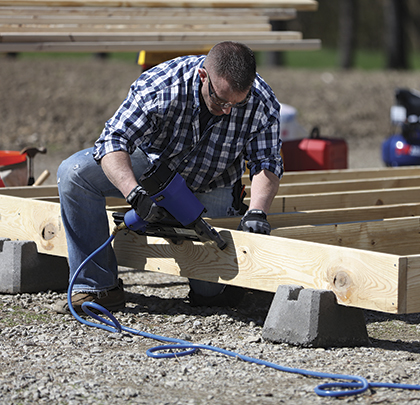Tools make work easier and faster. An air compressor is one of the most versatile tools available. Air is a powerful and reliable resource that can help you get the job done quickly. It can be used for a wide variety of projects, from inflating tires to powering tools for automotive or woodwork or framing.
Many contractors use both air-powered tools and electric tools on the jobsite. So, how do you know when to choose air power versus electric? The answer often depends upon the needs of the application and the tools being used.
While air power is not an option for every job or tool, it does offer versatility and benefits for operator comfort and safety in many applications. Whether you’re a DIYer or professional, consider the benefits of using air-powered tools with your air compressor.
ELECTRIC OR AIR POWER?
Despite the numerous benefits air power can provide, there are some cases where electric tools are the better choice for the job.
Cubic feet per minute (cfm) is the volume of air being delivered to an air tool; compressors with higher cfm ratings deliver more air. Generally speaking, a portable air compressor used on a jobsite won’t provide enough cfm to run larger-capacity tools such as drills, saws, and cutters. An air compressor capable of powering those types of tools would likely be 30 or even 60 gallons—and therefore not portable enough to be used on most jobsites.
For this reason, electric power is typically used for constant-run tools that require larger capacity and continuous power. Also, in jobs where greater mobility is a priority, electric tools that are battery powered do not require being tethered to a power source.
Air power is a good option on a jobsite for powering tools that require lower cfm levels, such as framing nailers, roofing nailers, finish nailers, stapler/fasteners, caulk guns, and paint sprayers. Most portable compressors used on a jobsite range in capacity from 2.5 to 5 cfm and can support these tools.
In the right applications, air power offers many benefits that can impact productivity, operator comfort, and safety.
LIGHTER WEIGHT REDUCES FATIGUE
Air tools offer a higher power-to-weight ratio than electric tools—meaning that comparable air tools are lighter weight but also offer higher power. This contributes to lower operator fatigue, which can help boost productivity and efficiency.
A typical pneumatic nailer weighs up to 40 percent less than the comparable electric tool, for example. On a jobsite where an operator uses a nailer for 7 or 8 hours at a time, even a few pounds difference adds up over the course of the day.
Having a lighter tool capable of completing the same work can have a significant impact on operator fatigue and productivity. When the operator doesn’t need to stop as often to rest, the job can be completed faster.
AIR RUNS COOLER
Air-powered tools also contribute to greater operator comfort because they run cooler than electric tools, which generate heat in performing work. In contrast, air tools generate cool air in performing work.
This is because the process of de-pressurizing air cools it down, which means air tools actually get colder the longer they run, while electric tools become hotter the longer they run. Air tools also cannot be damaged from overloading or stalling due to heat.
The result? Using air tools on the jobsite may require fewer breaks to let the tools cool down, which not only benefits operator comfort but also helps productivity and efficiency.

Featured Image: Air power is a good option for powering tools that require lower cfm levels, such as framing nailers, roofing nailers, finish nailers, stapler/fasteners, caulk guns, and paint sprayers. Most portable compressors used on a jobsite range in capacity from 2.5 to 5 cfm.
Above: Air is a powerful and reliable resource that can help you get the job done quickly. It can be used for a wide variety of projects, from inflating tires to powering tools for automotive or woodwork or framing.
SAFETY BENEFITS
Powering tools with compressed air is also a clean option that poses no fire hazard or electric shock potential. This not only benefits operator safety, but also productivity in the operation, since any worker injury can impact an operation’s bottom line due to unexpected downtime and loss of labor.
Another safety benefit of air power occurs when there is rain or inclement weather. If you’re working on a jobsite with an air tool and it starts raining, there isn’t a concern of electric shock—and work can even continue.
LOWER COST OF USE
Cost savings and saving time and money on equipment maintenance are priorities for many small businesses and contractors. Air tools are typically less expensive to purchase and usually offer lower maintenance costs over the life of the equipment compared to electric tools. Air tools provide low-cost maintenance and operation because they have fewer moving parts and simple design.
However, keep in mind that powering air tools also requires the purchase of an air compressor. Using the compressor to power many types of tools on a jobsite helps shorten the return on investment time.
Purchase costs for battery-powered nailers are typically up to 40 percent greater than pneumatic nailers on average.
In addition, air tools do not require batteries, which saves on battery costs over the life of the tool. This also enhances tool reliability, since there is no need to worry about batteries dying or needing to be charged while you’re completing a job.
DIY AND PROFESSIONAL AIR TOOLS
In choosing air tools, there are some key differences between those designed for use in DIY projects and those designed for use by professionals.
Product life expectancy is one example. Professional tools are designed and manufactured to perform in a more demanding environment. Since professional tools must hold up to more frequent use and greater wear and tear, the pneumatic system supporting these tools is also more complex. The higher cost of professional-grade tools typically reflects the inherent durability of these air tools.
While DIY tools are typically designed with the occasional user in mind, quality is also important for DIY users. Look for air-powered tools that offer durability and reliable performance to meet your various repair, maintenance, and construction needs.
THE BENEFITS OF CHOOSING AIR POWER
While not every tool or application is suitable for air power, many jobs are. Air power provides numerous benefits that can save you time and money on the jobsite.
Compared to electric tools, air-powered tools offer advantages for flexibility, since they can operate in areas where electric power sources aren’t available. They also offer low cost and benefits for productivity and safety. Consider the variety of tasks that air tools can perform to determine if they are the right option for your application. ■
About the Author:
Brandon Cross is an engineering/product manager with Campbell Hausfeld. For more information about compressors, visit www.campbellhausfeld.com.
_________________________________________________________________________
Modern Contractor Solutions, October 2017
Did you enjoy this article?
Subscribe to the FREE Digital Edition of Modern Contractor Solutions magazine.

Why Choose Air Power?


